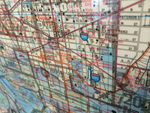Early & Viking Art
The first masterpiece discovered in Denmark was The Sun Chariot from the 14th century B.C. Found on the island of Zealand, it is a horse-drawn wagon with the image of a solar disk. It's made of bronze and laminated gold, revealing the high level of craftsmanship possible in Denmark at this time.
In the Viking Age (800-1100), Danish Vikings were influenced by the countries they conquered, especially Anglo-Saxon art styles. This fusion led to the creation of ferocious dragons and griffins, beasts with gaping jaws, and birds of prey. Christianity came in 826 and would have a great influence on art and architecture for centuries to come.
The Coming of Romanesque
The Romanesque period (1000-1250) overlapped the Viking period. In this era, wooden ecclesiastical buildings were the dominant theme, especially with the early churches made of wooden beams. In church architecture, wood eventually gave way to travertine, as evoked by the Church of Our Lady (c. 1110) in Roskilde.
Granite came into use later, and sections of the original Viborg Cathedral still remain to exemplify this style. In time, sandstone replaced granite. When supplies ran out, the Danes introduced brick, following examples set by the Lombards and Germans.
The oldest known ecclesiastical Danish paintings date from around 1100. Frescoes were used to decorate churches, such as those found in a rural church at Jelling.
The Gothic Era
The building of the great cathedrals of Denmark occurred in the Gothic period, roughly from 1250 to 1536. The French Gothic style prevailed in the reconstruction of St. Canute's, the cathedral of Odense, in 1250. Except for this cathedral, the French Gothic style did not catch on in Denmark.
The German influence prevailed in sculpture in Denmark during the medieval era. A masterpiece, the tomb of Queen Margaret (1423), in Roskilde Cathedral, was actually the work of a German, Johannes Junge, who was active in the early years of the 15th century.
Fresco paintings dominated in the small village churches, and they were fairly simple pastoral scenes -- somewhat like a flat tapestry design.
Later in the 14th century, French Gothic painting, as practiced in Lübeck, Germany, came to Denmark, inspiring such works as the Chapel of the Three Kings (1450) in Roskilde Cathedral.
The Renaissance Arrives
With the collapse of the Catholic Church, Protestantism was introduced in 1536. This marked a period of great artistic decline in Denmark, and much previous art was destroyed.
From the mid-1500s to the mid-1800s, the greatest architectural achievements were not reflected in cathedrals, but in castles, private villas, and royal palaces. For the most part, Flemish architects were imported to carry out the work. They constructed the original Kronborg Castle at Helsingør. Tourists today refer to it as "Hamlet's Castle."
During the reign of Christian IV (1577-1648), the reliance on foreign architects continued. However, he did employ several Danish architects in his attempt to turn Copenhagen into a modern city. They included Jorgen Friborg, who rebuilt Frederiksborg Castle, and the Steenwinkel brothers, who designed the original Stock Exchange in Copenhagen in 1619. Borrowing features derived from the architecture of The Netherlands, the brothers dominated building trends in Denmark in the latter half of the 1600s.
In sculpture, foreign artists dominated the medium, introducing French Baroque painting into Denmark. Painting during the Renaissance consisted mainly of court artists imported from Amsterdam.
The Neoclassical Era
In the reign of Frederick IV (1671-1730), Italian architecture heavily influenced Danish building, although French baroque and German Rococo were also dominant features.
A Dane, Nikolai Eigtved (1701-54), designed the palace at Roskilde (1733). He also drew up plans for the Amalienborg in Copenhagen, and was heavily influenced by his studies of architecture in Italy.
By the late 1700s, the Neoclassical style was firmly established in both architecture and sculpture in Denmark. Out of the many artists working at the time, the giant of Danish sculpture emerged, Bertel Thorvaldsen (1768-1844). His work evoked that of Antonio Canova in Italy, and there is a museum today in Copenhagen devoted to Thorvaldsen's sculpture.
Another major sculptor emerged in Kai Nielsen (1882-1924), who was influenced by August Rodin. Painting was somewhat lackluster during this era as various schools came and went, including the Skagen School, which was organized in North Jutland in 1880.
The Modern Period
Modern Danish architecture was born "between the wars." Such innovations occurred as housing projects for working people. Apartment houses were designed for city dwellers. Scale, materials, and color were of paramount importance to Danish architects. Interiors were made bright to fight against the bleakness of the Danish winter, and low and comfortable proportions were maintained.
From an array of architects at the time, Arne Jacobsen emerged as the leader of the pack. Since the 1930s, he produced Denmark's most original buildings, including terraced houses and several town halls.
Danish sculptors continued to follow contemporary international trends. Drawing the most attention was the Cobra group formed in 1948, its name based on the cities of Copenhagen, Brussels, and Amsterdam. The most outstanding Cobra artist from Denmark was Anger Jorn, born in 1914. His style was influenced by the more famous Edvard Munch of Norway.
In the closing years of the 20th century, Danish architecture increasingly was oriented toward Neo-Modernism. Both building forms and room layouts can be either severe and calm or highly dynamic, as evoked by Terminal 3 at Copenhagen's Airport. The most dramatic postmillennium structure in Denmark is the new Opera House in Copenhagen, dating from 2004.
Note: This information was accurate when it was published, but can change without notice. Please be sure to confirm all rates and details directly with the companies in question before planning your trip.








